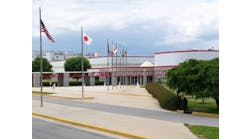Truck Tire Market Shifts Into High Gear - But Challenges Remain
The commercial truck tire segment has shifted into high gear as the trucking industry continues to gain momentum.
“Demand for commercial vehicles in North America is about as good as we’ve seen in 35 years of monitoring heavy-duty aftermarket conditions,” Kenny Veith, president of ACT Research, which tracks the North American trucking industry, recently said.
“The economy is carrying considerable pent-up industrial and consumer demand, with stimulus programs adding fuel to the fire.”
ACT Research’s gross domestic product (GDP)-based freight proxy “anticipates freight volumes jumping by 12.6%” during 2021.
However, some challenges for commercial tire manufacturers and dealers remain.
MTD recently asked tiremakers and marketers to comment on the truck tire market’s performance during the first half of the year and also provide a preview of what commercial tire dealers can expect to see during the second half.
Here’s what they had to say. (Responses are listed in alphabetical order, according to company name.)
MTD: What was the North American commercial truck tire market like during the first half of 2021?
Abhishek Bisht, assistant vice president, Americas, Apollo Tyres: The first half of 2021 saw much of the same continuation of commercial activities from 2020, but developing gradually. The trucking industry … continued to show pockets of continuous improvement, especially in the essential business categories. The increase in last-mile deliveries skyrocketed, placing increased demand on tire manufacturers to shift production schedules to accommodate sizes that addressed this segment. Any slowdown in this trend is highly unlikely.
Ben Johnson, director of marketing, Bridgestone Americas Tire Operations, U.S. and Canada: The North American commercial truck market has shown strength and resilience thus far in 2021. Overall, freight activity has been consistent versus prior-year since October 2020, with March being up nearly 10% compared to prior-year. The category has shown gro
Walt Weller, senior vice president, China Manufacturers Alliance LLC (CMA)/Double Coin: The North American commercial truck tire market has been one of vigorous growth through the middle of May 2021, both in the OE market and replacement market. When compared to the first half of 2020, 2021 growth has been quite remarkable, with growth in excess of 30% for OE and more than 20% for replacement. This is a trend that should continue through the end of 2021, but there are headwinds.
Tom Fanning, head of U.S. market for truck tires, Continental Tire the Americas LLC: The tire market was booming during the first quarter of 2021, with truck tire replacement shipments up 11% year-over-year, primarily among U.S. Tire Manufacturers Association (USTMA) members, who are up 12.5% year-over-year. Booming growth continued during 2Q, especially when compared to 2020 April/May, which were heavily impacted due to COVID-19. Freight indicators such as loadings, tonnage and rates were also up significantly. The trucking industry is currently in a very positive swing, with momentum heavily favoring shippers due to increased demand versus drivers available.The tire market will cool down, but remain strong in the second half of year, essentially an inverse of the trend witnessed in 2020 due to COVID-19.
Gary Schroeder, executive director, global truck and bus tire business, Cooper Tire & Rubber Co.: While most expected 2021 would be better than 2020, what the industry has seen so far is much stronger demand than most forecasted. The general shift to higher goods spending and less service spending has really boosted freight. This can be seen in strong Class 8 and dry van orders. In addition, business-to-consumer activity doesn’t appear to be slowing down, which is increasing final-mile freight.
Armand Allaire, executive vice president, commercial sales, North America, Giti Tire (USA) Ltd.: It was very healthy in demand, though challenged by the availability of containers and ship space to move containers. Cost increases from logistics often became a daily challenge. Still, consumers need their products and expect them to be delivered and that has kept a healthy pressure on the trucking community.
Rob Williams, vice president of U.S. TBR sales, Hankook Tire America Corp.: Current commercial truck tire demand is extremely strong and has continued to rise, even after a very strong 4Q 2020. Demand is far exceeding current supply in the market. Dealer supply is becoming very limited, as well, with manufacturers struggling to get product shipped and received in a timely manner.
Marshall Gillespie, manager of commercial and specialty proprietary brands, Hercules Tire (American Tire Distributors Inc.): Hercules has seen significant growth in light- and medium-duty truck tire sales. Delivery companies, such as Amazon, have grown their fleets to meet new demand with the explosion of e-commerce. The North American commercial truck tire market overcame many factors in 2020. With that said, demand rolled over into the first half of 2021.
Arun Bajoria, director and president, international operations, JK Tyre & Industries Ltd.: The North American economy is surging, putting the commercial truck tire market in a bright spot. With an intent to deliver goods on time, the sector is experiencing high demand for trucks and trailers. The orders from original equipment manufacturers continued to flow at an impressive pace. However, there has been an escalation in the cost of raw materials. This was followed by an increase in prices by several manufacturers and is likely to elongate the cycle further.
Rick Phillips, CEO, Keter Tire USA Inc.: Trucks are moving, so the truck tire business has been pretty good, but with a few challenges. Talking with our dealers, the three things we hear the most about are demand, supply and delivery. Demand for TBR products has been strong, but it seems to come in surges, making it harder to forecast. Supply has been spotty and the delivery of products, especially from off-shore, has been unpredictable. In spite of all of this, servicing dealers have done a great job of adapting and keeping their customers’ trucks on the road.
Jinki Shin, sales management manager, Kumho Tire USA Inc.: TBR demand grew explosively since November of last year. The trend persists in 2021, along with recovering new truck sales. I am hopeful about TBR sales for the first half of 2021, for both OE and replacement.
Pierluigi Cumo, director of marketing, on-road, Michelin North America Inc.: The North American tire market has continued to post-pandemic momentum from the second half of 2020 to the first half of 2021. This was primarily driven by the continued transition of consumer spending from services to goods that need to be transported around the country. The rise in rates for truckload and less-than-truckload carriers has brought profits into a freight market that cannot keep up with demand.
Ken Coltrane, director, marketing and product development, Prinx Chengshan Tire North America: Our growth has been strong. We are still a new company to the market, though, and if anything, that growth was hampered by the shipping challenges we’ve been experiencing.
Alan Eagleson, TBR segment manager, Sailun Tire Americas: The first half of 2021 was not without challenges. Although orders remained strong, we had to work very hard in dealing with freight challenges, including availability of containers, continued increase in demand for goods, the Suez Canal shutdown and increased freight rates. Truck tire inventories on the ground in the United States remain below recent averages and customer demand remains strong. This has created new opportunities for aftermarket commercial tire sales in both tier-two and tier-three truck tire brands, which our team has been focusing on.
Bob Klimm, director of commercial tire sales, Sumitomo Rubber North America Inc. (SRNA)/Falken: The year started off with very strong demand in the first quarter and saw a continuation through the second quarter. Overall, the first half of this year has exceeded our expectations. And that’s exactly what we’re hearing from our dealers. While all segments are pointing up, most have said their commercial business has surpassed their forecast. That, of course, is good news. With many manufacturing industries operating at their highest levels in quite some time and with construction starting to rebound, we could very well see robust demand continue throughout the year.
Bill Dashiell, senior vice president, commercial tire division, TBC Brands: Overall, the commercial truck tire market has experienced very strong demand, especially in tier-three and tier-four. Imported truck tires faced global logistics challenges, applying supply chain pressure across the industry. In the first half of 2021, significant raw material and freight cost increases caused manufacturers to raise pricing.
Joaquin Gonzalez Jr., president, Tire Group International Inc.(TGI)/Cosmo: The best way to describe the North American truck tire market in the first quarter was ‘robust.’ It is a segment of the business that had been playing catch-up ever since the onset of the pandemic. The first quarter saw demand rise to pre-pandemic levels, with much of that catch-up happening in the later part of the quarter. The question moving forward will be if there is enough supply to meet the rising demand across all tiers.
Dave Johnston Sr., manager, commercial products and business development, Toyo Tire U.S.A. Corp.: For the U.S. market, the industry was up about 12% versus last year in 1Q. 2021 began with a strong carry-over from 2020 for commercial truck tires across dealer groups. Sales continue to reach new highs with demand continuing to climb. Global logistics challenges, from container availability to shipping bottlenecks and driver shortages, continue to be a challenge.
Charles Luther, northeast regional manager, Triangle Tire USA: The first half of the year started slower than expected. However, business did pick up towards the end of the first quarter. The second quarter was only hampered by supply constraints. As supply increases, we anticipate a growth year in the TBR sector.
Brian Sheehey, vice president of marketing, Yokohama Off-Highway Tires America Inc.: The first half of 2021 was hot. We expected an uptick after 2020, but the demand was high and it’s been sustained across all categories in the truck market — longhaul, regional, construction — everything. The bad news in all this has been costs. The cost of raw materials has gone up substantially and the cost of shipping has been through the roof. There’s been a global shortage of containers, disruption at the Suez Canal and significant delays at ports worldwide, which add to the costs because the meter is always running on those cargo ships. We’re trying our best to mitigate some of those shipping costs.
Dan Funkhouser, vice president of commercial sales, Yokohama Tire Corp.: It was a continuation of the second half of 2020. Fleet demand was surprisingly strong throughout 2020 and continues to be in 2021. Most resellers, dealers and truck stops were selling 2019 inventory to fleets in the beginning of 2020. After the initial COVID-19 slump in April 2020 and the first half of May, dealer demand started to increase. That demand has continued to remain strong ever since. As manufacturers, we continue to do all we can to keep up with demand. The big change is the huge number of last-mile and home deliveries that are taking place. This has led to a large increase in demand for 16-inch to 19.5-inch products.
MTD: What trends do you anticipate during the second half of the year?
Bisht (Apollo): Pent-up fatigue from the pandemic is beginning to abate now that millions of Americans are getting vaccinated and people begin to feel safe again. With this return to a hint of normalcy, economists predict that the U.S. GDP will grow 7% to 8% this year. As the recovery continues and Americans feel less constrained, they will begin to juice the economy. As a result, money will be spent on goods that are delivered by trucks. This means every segment of the trucking industry will strengthen.
Johnson (Bridgestone): We expect demand to remain high across market segments as the North American market continues to rebound from the challenges of the pandemic. However, we expect that international supply chains of goods and materials will remain volatile and the lack of inputs to OE manufacturing may cause some disruptions in production. We anticipate this volatility will remain throughout the majority of the second half, but will begin to normalize as we move into 2022.
Weller (CMA): There has been a lot of discussion about the growth of the last-mile (segment) driving the market and while that certainly has been a factor, the major inputs for growth have been the pent-up demand in OE and replacement demand driven by lack of domestic TBR inventories. With these factors leading the way, the outlook for the second half of 2021 is continued strong demand. e potential spoilers are commercial driver shortages; the risk of excessive inflation, driven by rapidly rising costs associated with the supply chain, as well as government spending; availability of labor; and continued escalation of ocean freight and rail costs.
Fanning (Continental): Over the past decade, we have witnessed regional application shipments continuing to increase year in and year out, nearing long-haul volumes. However, most likely from COVID-19 impact in 2020, regional tire shipments fell 0.6%, while long-haul shipments actually gained 2.8% in terms of share, according to USTMA reporting. Despite this anomaly, the prior trend should maintain and eventually — potentially within the next five to 10 years — regional tires shipments will eclipse long-haul volumes.
Allaire (GITI): More of the same, with the increase in last-mile deliveries keeping demand on intermediate and short-run trucks and drivers.
Williams (Hankook): We believe the second half of the year will bring many of the same challenges as the first half, with continued supply issues remaining until shipping lanes are able to catch up. Expected demand for OE trailers should continue to grow from pent-up demand and lack of production in 2020. With expected increases in shipping costs, raw materials and possibly natural rubber shortages, we also expect to see the continuation of price increases.
Gillespie (Hercules): During the second half of 2020 and the first quarter of 2021, we saw a shift toward the value-tier brands in the replacement market. We see this trend continuing into the second half of 2021. We’re actively monitoring the progress of proposed infrastructure bills, which could continue the growth in the commercial replacement tire market.
Bajoria (JK Tyre): One of the biggest trends is something we are already witnessing — the acceleration of prices. A combination of factors — such as increased raw materials, higher shipping expenses and changing market conditions — are expected to further push prices. With greater reliance on e-commerce and demand for last-mile delivery services, a significant rise in medium truck tire demand is expected to quickly surpass pre-COVID-19 levels. Consumers are now helping shape mobility by opting for door-step delivery.
Phillips (Keter): We are pretty bullish on the rest of the year. As things continue to open up around the country, demand for TBR products will stay strong, especially those designed for vehicles in the e-commerce, construction and oil eld segments. We are seeing a spike in orders and runs on certain products to the extent there is a bit of concern about product shortages. There is definitely an increased appetite for hot SKUs.
Shin (Kumho): For the past six months, demand for TBR tires has been higher than supply. The increase in commercial trucking demand will keep TBR demands also high, but certain risk factors — such as lagging replacement supply due to port congestion and increasing OE demands — will eventually bring down sales of TBR tires in the second half.
Cumo (Michelin): The need for increased capacity within an expanding economy will give fleets incentives to continue expansion. OE markets are back on the upswing and the replacement tire market should benefit from the maintenance cycle of vehicles purchased within the past few years.
Coltrane (Prinx): Trucking will increase, trying to get more product inland from ports. This will mean more long-haul miles. The question is how much the (truck) driver shortage will impact that.
Eagleson (Sailun): Like all manufacturers and shippers of goods, the cost of raw materials has been impacted by freight cost. As we’ve continued to communicate to our valued customers, it looks like the current freight issues will continue through the rest of 2021 and into 2022. As life returns to some semblance of normal, service-based spending may also return. Until then, the majority of consumer goods being purchased are transported by ship, rail and road. Truck tires are a big component of that delivery chain.
Klimm (SRNA): Demand will continue to increase throughout the second half of 2021. The industry recovery will be segment-driven as we reopen the market for commerce. As industry continues to open up and restrictions are pulled back, we expect to see an aggressive uptrend in the replacement tire business. The last-mile segment will increase tire replacement behavior and timing, (as) 19.5-inch is now the third most popular size in the OE industry.
Dashiell (TBC): Global logistics issues due to COVID-19 will continue to challenge the commercial truck tire market, especially on import tires. Demand for low-profile tires also will continue, while a resurgence of urban market tires will occur as the economy rebounds.
Gonzalez (TGI): From a market perspective, I expect Commercial truck tires demand to remain strong. The challenge will be securing enough product to meet it. From a product perspective, I think we will continue to see migration from traditional long-haul and regional applications to more of a super-regional, all-in-one tire. This is from manufacturers rolling out new generations of models, as well as meeting today’s driver demands.
Johnston (Toyo): The second half of 2021 is expected to continue on a strong growth path. Increased COVID-19 inoculations and the resulting opening of the economy, combined with pent-up demand for truck tires to refill shelves, point to a strong second half. Logistics bottlenecks, combined with high shipping volumes, will need to balance with market demand to improve the situation. Equipment demand and driver shortages should start to improve as we near the end of 2021 and fleets are poised to grow as they ramp up to meet unprecedented demand in several sectors.
Luther (Triangle): With the ongoing recovery from the COVID-19 pandemic, we anticipate growth in the TBR market for the rest of 2021, going into 2022. Product shortages exacerbated by the pandemic and the onslaught of the global logistics breakdown have created some chaos in the potential growth of the TBR market. However, demand is there that will easily drive a growth market for TBR products, if the industry is able to deliver.
Sheehey (Yokohama Off-Highway): The second half of the year is still going to be robust and the effect of today’s supply chain disruptions will hit then, so dealers may struggle a bit more to get the truck tires they need.
Funkhouser (Yokohama Tire Corp.): With both OE and replacement demand being very strong, there will be a lot of pressure on tire manufacturers to keep up with supply. Once the backlog at the ports and the container issues are corrected, off-shore production should help relieve that pressure. With lower-than-normal store inventories, freight demand will continue to be strong and thus the demand for commercial truck tires will also be strong.




